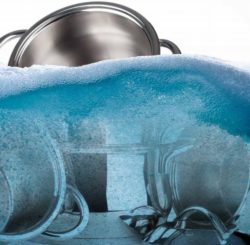4 Key Differences Between Continuous Motion and Cabinet Style Commercial Warewashing Systems
 In many ways, the Power Soak system and other “continuous motion” pot and pan washing systems use the same principles as cabinet style warewashing systems. Specifically, both types of systems incorporate the four time-tested key principles of warewashing:
In many ways, the Power Soak system and other “continuous motion” pot and pan washing systems use the same principles as cabinet style warewashing systems. Specifically, both types of systems incorporate the four time-tested key principles of warewashing:
- Time
- Temperature
- Detergents
- Mechanical action
In other ways, however, the two types of systems couldn’t be less alike. Let’s explore the key differences between them and why choosing one type of warewashing technology over the other can be vital to the success of your commercial kitchen operation.
- Continuous motion warewashing systems like Power Soak fully submerse wares for washing, whereas items being washed in cabinet style commercial dishwashers are racked and sprayed with wash, rinse and sanitizer solution. The racked items are stationary, and the wash jets rotate on spinning wash arms through the ware items. This differs dramatically from continuous motion warewashing systems, where the opposite action occurs: Jets are stationary and items are rotated through the wash water by the wash jets.
- Cabinet style warewashers typically operate on a fixed wash cycle and address soils that can be predictably removed from ware items such as plates and glasses within those cycle times. Power Soak and other continuous motion warewashing systems function on non-fixed cycle times, so various ware items can be unloaded as needed. For example, soils found on pots and pans are notoriously tough and inconsistent, and required wash times can be varied and unpredictable. With continuous motion warewashing, the wash time is not fixed and can be easily adjusted as needed to accommodate specific jobs.
- Additionally, the number of items per load in a continuous motion system is typically 4-8 times greater than the number of items that will fit on a typical single-spray dishwashing rack. This is a critical difference, as it resolves the need for washing a large number of items for longer and varied periods of time per load.
- Finally, the detergents used in cabinet style warewashing systems can be “hotter” (meaning higher PH levels) than the detergents used in continuous motion systems, which must be largely PH neutral as there is regular contact between the solution and the crewmember using the system. As is the case with any piece of commercial kitchen equipment, safety should be a primary consideration in the selection process.
There are other factors as well, so stay tuned! Future blogs will feature more in-depth discussions about the fundamentals of continuous motion warewashing systems like Power Soak as well as the critical design elements every operator should consider when they select their commercial warewashing system.
Chef Steve D’Angelo
Electrolux Professional Group Corporate Chef
[email protected]
 In many ways, the Power Soak system and other “continuous motion” pot and pan washing systems use the same principles as cabinet style warewashing systems. Specifically, both types of systems incorporate the four time-tested key principles of warewashing:
In many ways, the Power Soak system and other “continuous motion” pot and pan washing systems use the same principles as cabinet style warewashing systems. Specifically, both types of systems incorporate the four time-tested key principles of warewashing: